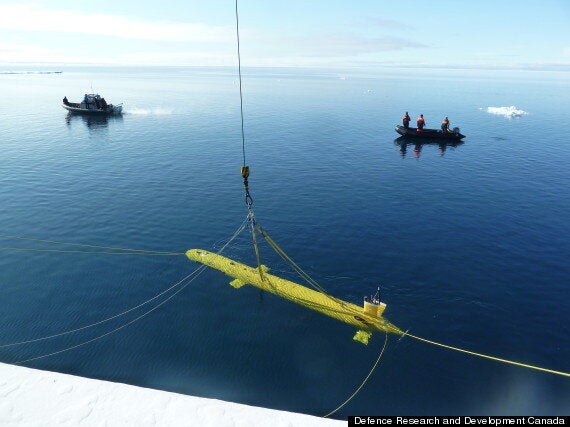For a wreck that has been underwater for almost 170 years, HMS Erebus looked almost perfectly preserved, the image so clear that viewers could almost see individual grains of sand. Resting more than 10 metres deep in icy Arctic waters, the long-lost ship was finally discovered thanks to state-of-the-art sonar, and was seen in detail using a robot able to grab video of the vessel, which was remarkably intact.
This kind of underwater technology won’t gather dust on a shelf now that the Franklin expedition is over. The research branch of the military isn’t naive about the possibilities that this technology holds for surveilling and mapping the Arctic. The kind of robots used on the expedition are just one-tenth the size and far cheaper than the average icebreaker that the military has typically relied on in the Far North.

One of the Arctic Explorer AUVs owned by the Canadian government being deployed in Arctic waters.
Rob Huebert, an Arctic expert from the University of Calgary, says new equipment designed to keep a close watch on our northern borders will become increasingly important, especially with “aggressive and “expansionist” neighbours such as Russia.
“There’s been a realization that the Arctic isn’t an isolated area anymore,” he said. “We have to watch the larger geopolitical picture.”
While the military’s own autonomous underwater vehicles (AUVs), both called Arctic Explorer, weren’t the devices that found the Franklin wreck, they’ve already been put to work elsewhere in the Arctic. One has been used on several mapping expeditions to measure sea depth as part of Canada’s most recent submission to the UN, as countries can claim an extension of their borders based on how far the continental shelf stretches out from the coastline. Other countries like Russia and Denmark are also making submissions to the UN to extend their northern borders.
Arctic Explorer is built specifically to go under the ice, and holds the world record for operating time. On one of its mapping trips, it covered 1000 km in 10 days, and only needed to be charged twice, said David Hopkin, a senior researcher at Defence Research and Development Canada (DRDC). Scientists also developed a unique homing system for the AUV that allowed it to find its operators when they were on a moving ice floe.
The government bought the vehicles from a Vancouver company in 2009 for around $5 million, but so far they’ve only been used by DRDC for ocean mapping, the search for Franklin and other research. The military hasn't purchased any for their own missions, said Hopkin, but they’ve expressed interest in Arctic Explorer’s capabilities.
“The navy asked us how does this work in cold water,” he said. “We have evidence that it works amazingly well in the Arctic. It exceeds all capability of equipment right now.”
James S. Collins, a University of Victoria professor who specializes in underwater robotics, said unmanned vehicles still have limitations, like communicating with their operators and staying charged for long periods of time, but as they improve, they could be a useful tool for missions like watching over an enemy’s harbour.
“You can’t hover around quietly the same way with a manned vehicle,” he said.
But the AUVs would be useless without the ability to take underwater images. Arctic Explorer is fitted with a cutting-edge, Canadian-made sonar system originally made to find and classify naval mines.
Dave Shea, engineering manager at Kraken Sonar, was on board one of the Franklin expedition vessels, processing images from Arctic Explorer. He said his company’s synthetic aperture sonar, which takes very high-resolution, 3D images of the ocean floor, is the “next generation” of sonar equipment.
“It’s a pretty powerful tool.”

An image of the uncharted Arctic sea floor captured by Arctic Explorer using Kraken Sonar's equipment.
Scientists are also studying the use of autonomous vehicles on land and in the air.
A DRDC team travelled to remote Alert, on Ellesmere Island, in mid-August to test how unmanned aerial and ground drones operate in the harsh Arctic. They put the vehicles into situations that might normally be risky for Canadian Forces personnel.
While AUVs are by no means a new technology, the global push to use them and other unmanned vehicles is ramping up. At least 75 countries, including the U.S., are investing in robotics, according to the Centre for a New American Security.
The global market for defense robotics is estimated to reach $7.5 billion U.S. by 2018, according to a report from Global Industry Analysts.
But this isn’t the only new technology Canada has explored. Since 2008, DRDC has sent staff to remote Devon Island, across from Greenland, to test underwater surveillance equipment that would watch over the Northwest Passage.
Called the Northern Watch Program, the project would see long cables installed under the ocean to listen for submarines or ships, The Canadian Press’ Bob Weber reported in 2012. Equipment that picks up on mandatory broadcasts from large vessels would also be installed, as well as a radar intercept system and lasers that can see across the foggy strait.
The government planned to resume work on the high-tech listening network after a hiatus, CP reported, but it’s unclear if the project ever got off the ground.
While the Harper government has announced plans for a number of northern projects, like building a naval station on Baffin Island, updating our fleet of icebreakers and building eight new Arctic patrol ships, none of these have materialized.
But cheaper, smaller Arctic drones could be a new way to keep watch over the North.
“The military classically likes to think in terms of putting men in seats... but times are changing,” said Collins.
CLARIFICATION: A previous version of this story implied that a robotic vehicle first spotted the Erebus, when in fact it was a towed side-scan sonar device that initially saw it.
Also on HuffPost
